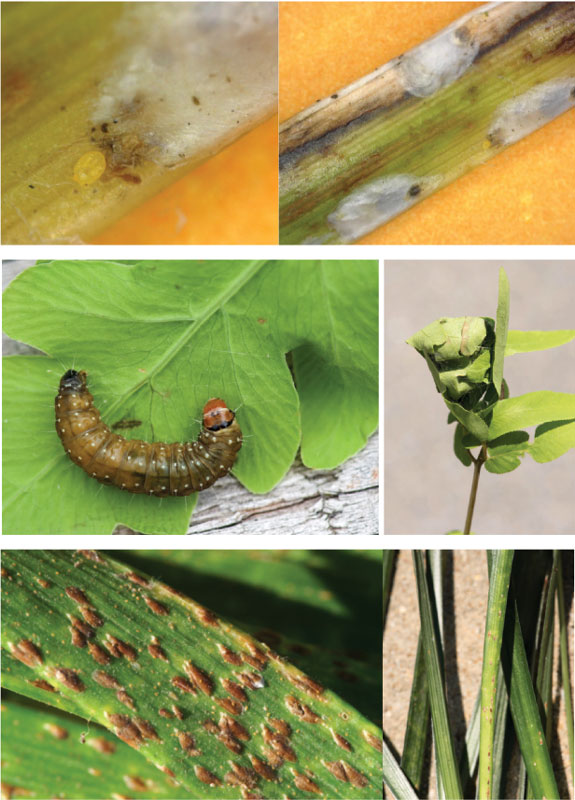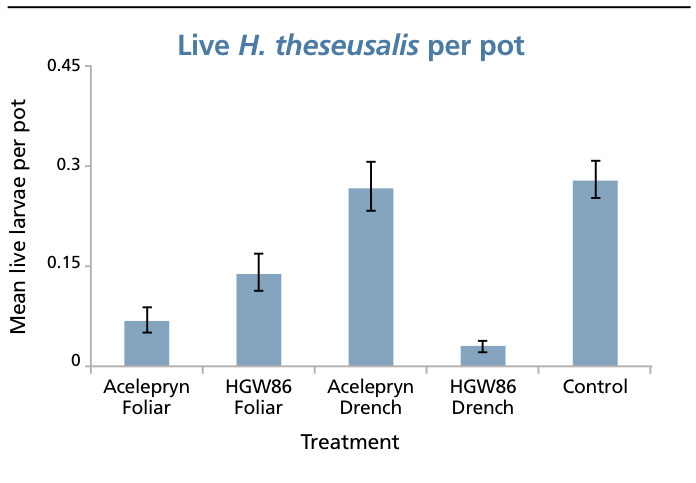12/1/2020
Major Pests of Herbaceous Perennials
Stanton Gill

In July of 2020, David Clement and I presented on some of the major insects and diseases of herbaceous perennials at Cultivate’20 Virtual. I’ll give a short summary of a couple of the key insects here, and David Clement will cover some of the key diseases you should be monitoring for in your nursery and landscape, in a separate article.
Pictured: • Duplachionaspis divergens scale on Acorus gramineus Variegatus.
• Leaf folder caterpillar (Herpetogramma theseusalis) late instar larva.
• Leaf folder caterpillar damage on royal fern.
• Fern scale on liriope.
First off, here’s a good humor story involving perennials (a young worker at an herbaceous perennial nursery called in with this one): She was working on dividing perennials, and for entertainment, was listening to a podcast on her phone. During the podcast, the transmission started stuttering, with intermittent pauses. She pulled her phone out of her pocket and found a garden slug was gliding over the touch screen part of the screen, leaving a slime trail. She wiped off the slime, along with the slug, and the podcast immediately stopped stuttering. Something in the slug slime or the slug on the screen was interfering with the touch screen and the podcast transmission. It goes to show that bugs and arthropods affect our perennial growers in many ways.
Fern pests
One of the popular herbaceous perennials grown in nurseries and used in shady landscapes are native ferns. One of the major insects that’s become established across the middle and eastern part of the United States is a pest of the beloved ferns group—a moth in the Crambidae family. This moth is commonly called the leaf folder caterpillar (Herpetogramma theseusalis). It’s found in North America where it’s been recorded from Alabama; Florida; Maine; Maryland; North Carolina; Quebec, Canada; South Carolina; Texas; and Virginia.
The leaf folder caterpillar damages several native species of ferns—we’ve found it damaging sensitive fern, marsh fern, royal fern, Interrupted fern and shielded fern in Maryland. The caterpillar has been recorded in the south on Lorinseria areolata, the netted chain fern, native to eastern North America.
Adults are active and on wing from April to September in Maryland. The moth is a night flyer. If you walk through infested ferns in the daylight, the moth will fly up, zig-zag back and forth, and dive into foliage rapidly. You can catch them with a small sweep net.
Adults deposit eggs onto the fern foliage. The caterpillar puts out silk from its mouth and webs the foliage of the fern together in a bizarre rectangular box shape. The leaves webbing together is almost attractive-looking. The larvae hides in the folded leaf box during the day and come out at night to feed on the foliage of the fern.
 Back in 2010, when DuPont was developing chemicals for ornamental insect control, they funded a trial we conducted over two years in an herbaceous perennial nursery in Maryland. We were testing new systemic materials DuPont was bringing into the market. One was called Acelepryn; the other was a numbered compound, HGW86, which is now sold under the name Mainspring. (Both of these products are now distributed by Syngenta company.) We tested both foliar and drench applications. The drench of HGW86 performed the best in controlling the larvae. One application gave us 10 to 12 weeks of control.
Back in 2010, when DuPont was developing chemicals for ornamental insect control, they funded a trial we conducted over two years in an herbaceous perennial nursery in Maryland. We were testing new systemic materials DuPont was bringing into the market. One was called Acelepryn; the other was a numbered compound, HGW86, which is now sold under the name Mainspring. (Both of these products are now distributed by Syngenta company.) We tested both foliar and drench applications. The drench of HGW86 performed the best in controlling the larvae. One application gave us 10 to 12 weeks of control.
Fern scale
One of the most popular herbaceous perennials is liriope/mondo grass. It’s been grown in greenhouses and nurseries for large landscape planting beds. The plants are adapted for uses in sun and partly shaded landscapes. One of the big pests that plagues this plant is an armored scale that’s commonly called the fern scale (Pinnaspis aspidistrae). It does get on ferns, as the common name implies, but it’s more commonly found on liriope/mondo.
It also infests other plants, including palms, bird of paradise, chamaedorea, chrysalidocarpus, dracaena, ficus, lady palm, monstera, ophiopogon, Phoenix roebelenii, staghorn fern and ti plant (Cordyline fruticosa). For most herbaceous perennial growers, this scale is mainly something to monitor for on liriope/mondo plants. As with most armored scale, it tends to blend in with the foliage of the plant and goes undetected in the propagation stage, and once established in a growing area, is easily spread from plant to plant by the crawler stage.
Like most armored scale, the female gives birth under the cover that surrounds her body. Crawlers hatch from the eggs and eventually emerge from under the mother's armor. The crawlers move about until they begin to feed by inserting thread-like mouthparts into the leaf and sucking out nutrients. The crawlers excrete wax to cover their body and remain immobile, feeding on the plant tissues.
The male feeds until the second instar stage, when it goes into a pre-pupal stage and then into the pupal stage. The male emerges as a small gnat–like insect, with one pair of wings, and often goes unnoticed. The female continues to feed into the mature third instar stage. The female mates with the winged adult male and the eggs mature inside the body of the female scale. Multiple generations per year can occur, depending on location and growing conditions. Here in Maryland, outdoors, the scale has two generations per year.
The key with control is to monitor liriope/mondo regularly, looking for the sessile stages of the scale. If detected, several of the systemic insecticides can be used for control. Dinotefuran and Altus are two systemic insecticides that can be used. The insect growth regulators Talus and Distance will work well if you can catch the scale at the crawler and first instar stage.
Ornamental grass scale
The last insect we’ll cover is one that’s being found on ornamental grasses. It’s an armored scale we found in an herbaceous perennial nursery in Maryland in 2020 called Duplachionaspis divergens. It’s from the Orient and doesn’t have a recognized common name in America. This armored scale was first recorded in Florida and the U.S. from specimens collected on a grass in Sanford (Seminole County), Florida, on November 1, 2002 by Amanda Melco. However, a re-examination of specimens collected in Bradenton (Manatee County), Florida, on Miscanthus sp. on September 6, 2000 by Mark Runnals is the earliest known record of this species occurring in Florida.
Here in Maryland, one of the professional IPM Scouts, Heather Zindash, found it on Acorus gramineus Variegatus in an herbaceous perennial nursery. It’s been reported feeding on Miscanthus sinensis and Pennisetum alopecuroides in the Midwest and Florida.
The armored scale Duplachionaspis divergens has a very noticeable white, elongated scale cover. By flipping the scale cover off, one can observe the body of the adult female, which is yellow in color with an elongated body shape. Little is known about the biology of this insect.
Regular monitoring and destroying of infested plants is the best course of action. The control methods mentioned under the fern scale should provide control if chemical treatments are needed.
Staying vigilant in a perennial nursery with a regular monitoring program as part of your IPM approach is the best course of action in catching these insects early and dealing with them before they become a major problem. GT
Stanton Gill is an Extension Specialist in IPM and Entomology at the University of Maryland Extension, Central MD Research and Education Center, and Professor in the Landscape Technology Program at Montgomery College. He can be reached at Sgill@umd.edu.